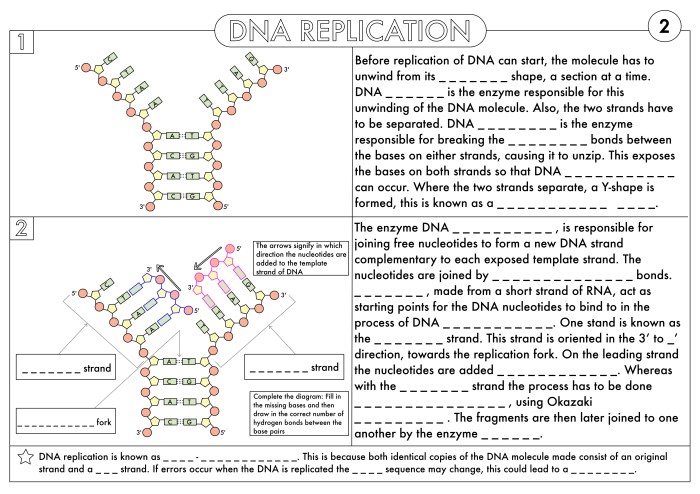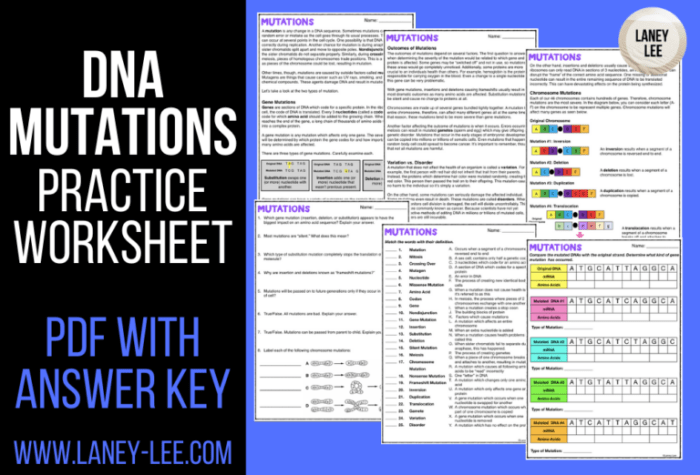Delve into the realm of genetics with Mutations Worksheet Answer Key Biology, an illuminating resource that unlocks the secrets of genetic variation. This comprehensive guide empowers students with a thorough understanding of mutations, their diverse types, and their profound impact on biological systems.
Prepare to embark on a captivating journey through the intricacies of DNA, where mutations emerge as the driving force behind genetic diversity and the foundation of evolutionary processes. Discover the mechanisms involved in mutation detection and analysis, unraveling the mysteries of genetic disorders, and explore the cutting-edge applications of mutations in biotechnology.
1. Mutations and Genetic Variation: Mutations Worksheet Answer Key Biology
Mutations are changes in the DNA sequence of an organism. They can be spontaneous or induced by environmental factors such as radiation or chemicals. Mutations can have a wide range of effects on an organism, from being completely harmless to causing severe genetic diseases.
Different Types of Mutations
- Point mutations: These are changes in a single nucleotide base pair in the DNA sequence.
- Insertions and deletions: These are mutations that add or remove nucleotide base pairs from the DNA sequence.
- Chromosomal mutations: These are mutations that affect the structure or number of chromosomes.
Potential Effects of Mutations
Mutations can have a variety of effects on an organism, including:
- Neutral mutations: These mutations have no effect on the organism.
- Beneficial mutations: These mutations provide a selective advantage to the organism.
- Deleterious mutations: These mutations have a negative effect on the organism.
Examples of Mutations with Significant Impacts
Some mutations have had a significant impact on biological systems, including:
- The sickle cell anemia mutation is a point mutation that causes the production of a defective form of hemoglobin. This mutation can lead to sickle cell disease, a painful and potentially fatal condition.
- The cystic fibrosis mutation is a deletion mutation that causes the production of a defective form of the cystic fibrosis transmembrane conductance regulator (CFTR) protein. This mutation can lead to cystic fibrosis, a chronic respiratory disease.
- The Huntington’s disease mutation is a trinucleotide repeat expansion mutation that causes the production of a defective form of the huntingtin protein. This mutation can lead to Huntington’s disease, a fatal neurodegenerative disorder.
2. Mutation Detection and Analysis
Mutation detection and analysis are essential for understanding the role of mutations in genetic variation and disease. There are a variety of techniques that can be used to detect and analyze mutations, including:
Techniques for Mutation Detection
- DNA sequencing: This is the most accurate method for detecting mutations. It involves determining the sequence of nucleotides in a DNA sample.
- PCR-based methods: These methods use the polymerase chain reaction (PCR) to amplify a specific region of DNA. Mutations can be detected by comparing the sequence of the amplified DNA to the normal sequence.
- Microarrays: These are chips that contain thousands of DNA probes. Mutations can be detected by hybridizing the DNA sample to the probes and looking for mismatches.
Importance of Mutation Analysis
Mutation analysis is important for a variety of reasons, including:
- Research: Mutation analysis can be used to identify the genetic causes of disease and to study the evolution of species.
- Diagnostics: Mutation analysis can be used to diagnose genetic diseases and to identify individuals who are at risk for developing these diseases.
- Treatment: Mutation analysis can be used to develop targeted therapies for genetic diseases.
Examples of How Mutation Analysis Has Advanced Scientific Understanding and Improved Healthcare
Mutation analysis has been used to make significant advances in our understanding of genetic diseases and to improve healthcare. For example, mutation analysis has been used to:
- Identify the genetic cause of cystic fibrosis.
- Develop a targeted therapy for chronic myeloid leukemia.
- Identify individuals who are at risk for developing breast cancer.
3. Mutation Impact on Biological Systems

Mutations can have a wide range of effects on biological systems, depending on the type of mutation and the location of the mutation in the genome. Mutations can affect gene function, protein structure, and cellular processes.
Gene Function
Mutations can affect gene function by altering the sequence of nucleotides in the coding region of the gene. This can lead to the production of a defective protein or to a complete loss of protein function.
Protein Structure
Mutations can also affect protein structure by altering the sequence of amino acids in the protein. This can lead to a change in the shape or function of the protein.
Cellular Processes
Mutations can also affect cellular processes by altering the expression of genes. This can lead to changes in the production of proteins and to changes in the function of cells.
Examples of Mutations that Have Led to Genetic Diseases or Disorders
Some mutations have led to genetic diseases or disorders, including:
- Sickle cell anemia: This is a genetic disease caused by a point mutation in the beta-globin gene. This mutation leads to the production of a defective form of hemoglobin, which can cause red blood cells to become sickle-shaped.
- Cystic fibrosis: This is a genetic disease caused by a deletion mutation in the CFTR gene. This mutation leads to the production of a defective form of the CFTR protein, which can cause mucus to build up in the lungs and other organs.
- Huntington’s disease: This is a genetic disease caused by a trinucleotide repeat expansion mutation in the huntingtin gene. This mutation leads to the production of a defective form of the huntingtin protein, which can cause nerve cells to die.
4. Mutation Repair and Prevention

DNA repair mechanisms are essential for maintaining the integrity of the genome. These mechanisms can repair damaged DNA and prevent mutations from occurring.
DNA Repair Pathways, Mutations worksheet answer key biology
There are a variety of DNA repair pathways that can repair different types of DNA damage. These pathways include:
- Base excision repair: This pathway repairs damage to individual nucleotides.
- Nucleotide excision repair: This pathway repairs damage to a stretch of nucleotides.
- Mismatch repair: This pathway repairs mismatches between the two strands of DNA.
- Double-strand break repair: This pathway repairs breaks in both strands of DNA.
Role of DNA Repair Pathways in Maintaining Genetic Integrity
DNA repair pathways play a critical role in maintaining the integrity of the genome. These pathways can repair damaged DNA and prevent mutations from occurring. This is essential for the survival of cells and organisms.
Strategies for Preventing Mutations
There are a number of strategies that can be used to prevent mutations, including:
- Genetic counseling: Genetic counseling can help individuals understand their risk of developing genetic diseases and make informed decisions about their reproductive choices.
- Lifestyle modifications: Certain lifestyle modifications, such as avoiding exposure to radiation and chemicals, can help to reduce the risk of mutations.
5. Mutation Applications in Biotechnology
Mutations are used in a variety of biotechnology applications, including:
Gene Editing
Mutations can be used to edit genes in a precise way. This can be used to correct genetic defects or to introduce new genes into cells.
Genetic Engineering
Mutations can be used to create genetically modified organisms (GMOs). GMOs are organisms that have had their DNA altered in a way that does not occur naturally.
Bioremediation
Mutations can be used to create microorganisms that can degrade environmental pollutants. This can be used to clean up contaminated soil and water.
Examples of How Mutations Have Been Harnessed for Practical Applications
Mutations have been harnessed for a variety of practical applications, including:
- Gene therapy: Gene therapy uses mutations to correct genetic defects in patients.
- Biofuels: Biofuels are fuels that are produced from renewable resources. Mutations can be used to create microorganisms that can produce biofuels more efficiently.
- Bioplastics: Bioplastics are plastics that are made from renewable resources. Mutations can be used to create microorganisms that can produce bioplastics more efficiently.
FAQ Section
What is the significance of mutation analysis in research and diagnostics?
Mutation analysis plays a crucial role in identifying genetic variations associated with diseases, enabling accurate diagnosis, personalized treatment, and genetic counseling.
How do mutations contribute to genetic diseases?
Mutations can alter gene function, disrupt protein structure, and impair cellular processes, leading to the development of genetic diseases such as cystic fibrosis, sickle cell anemia, and Huntington’s disease.
What strategies can be employed to prevent mutations?
Preventive measures include genetic counseling to assess familial risk, lifestyle modifications such as avoiding exposure to carcinogens and radiation, and prenatal screening to identify potential genetic abnormalities.